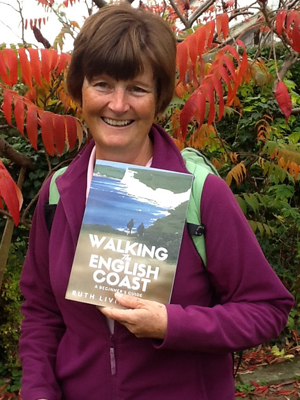For those of you who don’t know, NaNoWriMo is a crazy writing project that happens every November, with the goal of getting authors (whether amateur or professional) to write an amazing 50,000 words in one month! That’s 1,667 words a day. Still in shock? Check out I_AM Self-Publishing’s Beginner’s Guide to NaNoWriMo here.

Author Ruth Livingstone, knows a thing or two about time management and productivity, which is something all authors struggle with. In fact, she has successfully completed NaNoWriMo five times! She has just published Walking The English Coast, which started life as a NaNoWriMo project and shares her top tips here.
1. Get a notebook
Label it with the name of your story, and keep it beside your keyboard. You’re going to need it.
2. Do any research you need in advance
In your notebook, write down notes on characters and locations, and, most importantly, write down a basic outline of your story. It’s a good idea to really get to know your characters inside and out before you start writing. A really easy way to build up a character profile is this NaNoWriMo Characterisation checklist.
Some people are natural planners. Others, myself included, are pantsters, which means we like to fly by the seat of our pants and go where the story takes us. During NaNo, you won’t have time to re-read what you’ve written, scrub out false starts, or turn back from dead ends, so it’s a good idea to have an idea of the way you’re intending to go. At the minimum, have a starting point and write down some key scenes in your notebook. Better still, have an end point too. Then if you get stuck, just leave a blank space in your document and move on to your next key scene and pick up the story from there.
3. As you write, note down any key points about your characters or the plot in your notebook
For example, if your hero was born on the 1st April 1991 in Scunthorpe, make a note of this. If your heroine has blue eyes and is left-handed, write this down too. You may think you are never going to forget these details, but after 20 days of furious writing, you’ll find many little things will have slipped out of your conscious memory. Rather than scrolling back through pages of eye-blurring text, just look in your notebook for the details you need.
4. Write something new every day, even if it’s just a few hundred words.
If you miss a day completely, don’t panic; just make sure you write an extra hundred words on the next few days. Keep going. Don’t give up. Drink coffee. Skip sleep. Keep on typing. If you come to a bit of a block, write an obvious note to yourself in the text so that you can return and insert the section later. Remember, this is your first draft and it doesn’t have to be perfect.
5. Back up your writing on a daily basis
Don’t lose your work! I recommend Dropbox, which has the added advantage that you can work on your story from any computer with an Internet connection, even when you’re away from home.
And here’s a bonus NaNoWriMo tip: You don’t have to write a novel. You can be a NaNo Rebel. In fact, there’s a special NaNo Rebels forum on the NaNoWriMo site, just for us non-fiction writers. For example, I used NaNo 2014 to get down the basic text for my latest book, Walking The English Coast.
Good luck! Let us know how you get on in the comments box below.

Very inspirational, thanks - and I love the practical tips plus the subject matter of the book